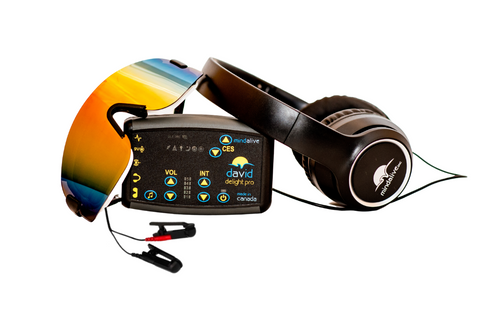Many years ago, after reviewing the research on using CES for ADHD, we decided to combine our ADHD sessions on the ALERT (now since discontinued) to create the ALERT Pro (also discontinued) Audio-Visual Entrainment (AVE) devices with Cranio-Electro Stimulation (CES), as we found that adding CES boosted the effect of the AVE on ADHD symptoms. Our current device with both AVE and CES is the DAVID Delight Pro which includes sessions specifically for ADHD.
Introduction
Children with ADHD and behavioral disorders (BD) often struggle with compounded issues such as insomnia, depression, anxiety, poor cognition (mental performance), and a tendency to experiment with drugs. Parents and clinicians using the ADHD sessions in the Delight Pro are experiencing very positive results and those that have used AVE with CES say that effects are enhanced when using them both together.
Also, ADHD children often struggle with anxiety. It often isn’t practical to put them on an AVE session, so the parent can easily connect them to the CES part of the device, and they can continue doing homework, watching TV, doing the dishes, or other activity while being kept calm and relaxed during their activity. They can even go to bed with the CES running and fall into deep sleep with greater ease and depth of sleep.
The headphones and eyesets may be unplugged, allowing the user to run the CES only (earclips), while going about their day.
How effective is CES for children?
A study by Ray Smith (1992), of 23 children with ADHD using CES for 45 minutes per day for three weeks showed profound effects in reducing state anxiety (anxiety in the moment), trait anxiety (overall anxiety), and depression (Figure 1).
Figure 1. Improvements in Anxiety and Depression Following Treatment with CES

A follow-up after 18 months of discontinuation of CES use showed that the effects were still holding quite well. Ray also measured IQ and found significant improvements (Figure 2), which also held over 18 months.
Figure 2. Improvements in IQ Following Treatment with CES.

A 1999 controlled study (n=21) by Susan Southworth, on attention and concentration of normal students found that one session of CES for just 20 minutes improved attention by 31%, whereas the placebo group improved by only 4%.
Conclusion
There certainly is ample research demonstrating the effectiveness of CES for treating both mood and performance, which may be used as an adjunct to AVE stimulation in the management of ADHD symptoms.
Original by Sima Chowdhury (2012) Edited by Dave Siever (2023)

